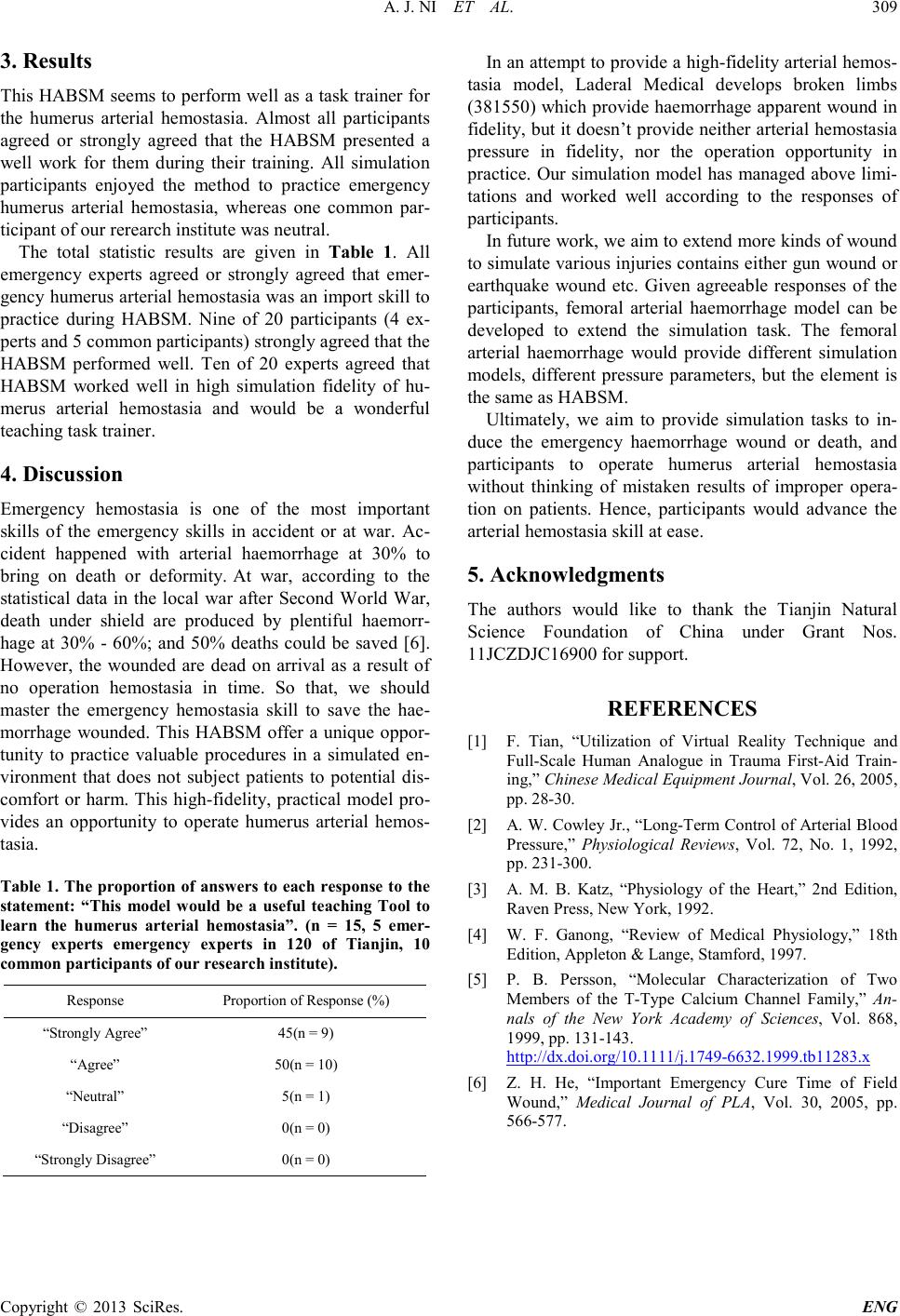
A. J. NI ET AL.
Copyright © 2013 SciRes. ENG
3. Resul ts
This HABSM seems to perform well as a task trainer for
the humerus arterial hemostasia. Almost all participants
agreed or strongly agreed that the HABSM presented a
well work for them during their training. All simulation
participants enjoyed the method to practice emergency
humerus arterial hemostasia, whereas one common par-
ticipant of our rerearch institute was neutral.
The total statistic results are given in Table 1. All
emergency experts agreed or strongly agreed that emer-
gency humerus arteria l hemostasia was an import s kill to
practice during HABSM. Nine of 20 participants (4 ex-
perts and 5 common participants) strongly agreed that the
HABSM performed well. Ten of 20 experts agreed that
HABSM worked well in high simulation fidelity of hu-
merus arterial hemostasia and would be a wonderful
teaching task tra iner.
4. Discu ssion
Emergency hemostasia is one of the most important
skills of the emergency skills in accident or at war. Ac-
cident happened with arterial haemorrhage at 30% to
bring on death or deformity. At war, according to the
statistical data in the local war after Second World War,
death under shield are produced by plentiful haemorr-
hage at 30% - 60%; and 50% deaths could be saved [6].
However, the wounded are dead on arrival as a result of
no operation hemostasia in time. So that, we should
master the emergency hemostasia skill to save the hae-
morrhage wounded. This HABSM offer a unique oppor-
tunity to practice valuable procedures in a simulated en-
vironment that does not subject patients to potential dis-
comfort or harm. T his high-fidelity, practical model pro-
vides an opportunity to operate humerus arterial hemos-
tasia.
Table 1. The proportion of answers to each response t o the
statement: “This model would be a useful teaching To ol to
learn the humerus arterial hemostasia”. (n = 15, 5 emer-
gency experts emergency experts in 120 of Tianjin, 10
common participants of our researc h institute).
Response Proportion of Response (%)
“Strongl y Agree” 45(n = 9)
“Agree” 50(n = 10)
“Neutr al” 5(n = 1)
“Disagree” 0(n = 0)
“Strongl y Dis agree” 0(n = 0)
In an attempt to pro vide a high-fidelity arterial he mos-
tasia model, Laderal Medical develops broken limbs
(381550) which provide haemorrhage apparent wound in
fidelity, but it do esn’t provide neither arter ial hemostasia
pressure in fidelity, nor the operation opportunity in
practice. Our simulation model has managed above limi-
tations and worked well according to the responses of
participa nts.
In futur e work, we ai m to exte nd mor e kind s of wound
to si mulate vario us inj uries conta ins ei ther gun wound or
earthquake wound etc. Given agreeable responses of the
participants, femoral arterial haemorrhage model can be
developed to extend the simulation task. The femoral
arterial haemorrhage would provide different simulation
models, different pressure parameters, but the element is
the same as HABSM.
Ultimately, we aim to provide simulation tasks to in-
duce the emergency haemorrhage wound or death, and
participa nts to operate humerus arterial hemostasia
without thinking of mistaken results of improper opera-
tion on patients. Hence, participants would advance the
arterial hemostasia skill at ease.
5. Acknowledgments
The authors would like to thank the Tianjin Natural
Science Foundation of China under Grant Nos.
11JCZDJC16900 for support.
REFERENCES
[1] F. Ti an, “Utilization of Virtual Reality Technique and
Full-Scale Human Analogue in Trauma First-Aid Train-
ing,” Chinese Medical Equipment Journal, Vol. 26, 2005,
pp. 28-30.
[2] A. W. C owl ey Jr ., “Long-Term Control of Arterial Blood
Pressu re,” Physiological Reviews, Vol. 72, No. 1, 1992,
pp. 231-300.
[3] A. M. B. Katz, “Physiology of the Heart,” 2nd Edition,
Raven Press, New York, 1992.
[4] W. F. Ganong, “Review of Medical Physiology,” 18th
Edition, Appleton & Lange, Stamford, 1997.
[5] P. B. Persson, “Molecular Characterization of Two
Members of the T-Type Calcium Channel Family,” An-
nals of the New York Academy of Sciences, Vol. 868,
1999, pp. 131-143.
http://dx.doi.org/10.1111/j.1749-6632.1999.tb11283.x
[6] Z. H. He, “Important Emergency Cure Time of Field
Wound,” Medical Journal of PLA, Vol. 30, 2005, pp.
566-577.